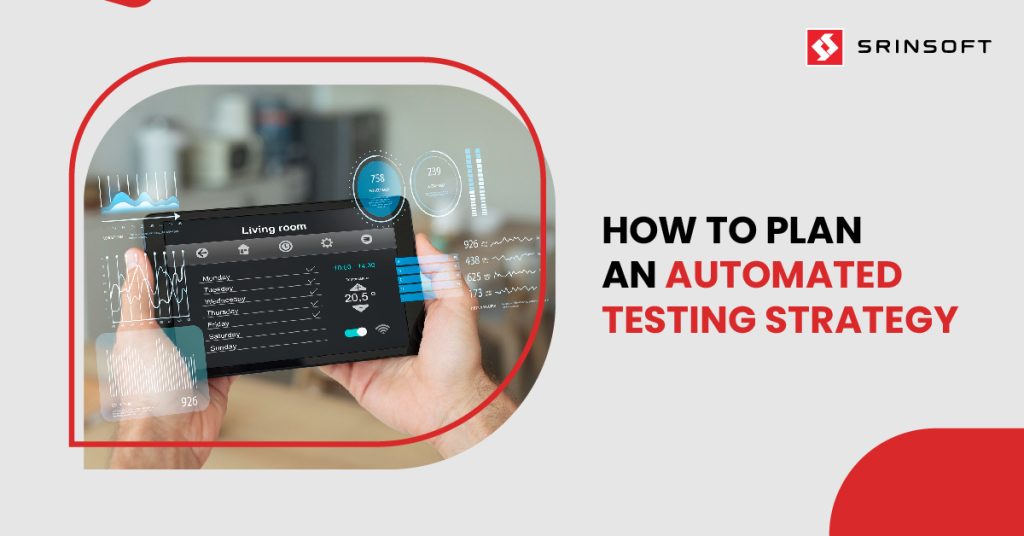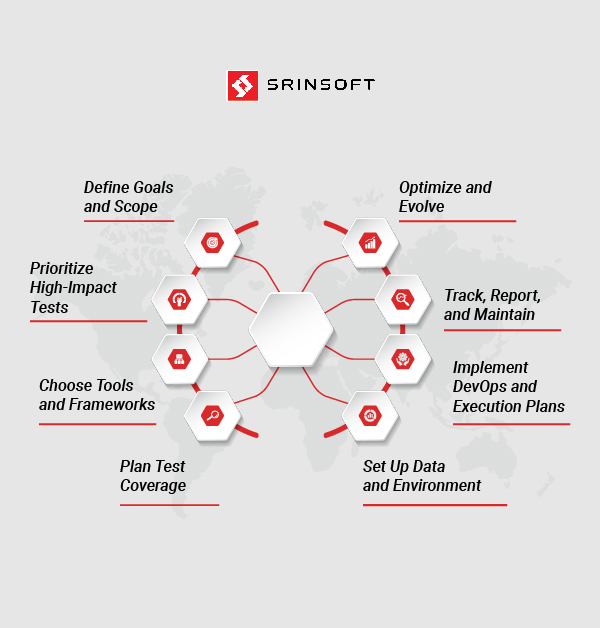
What is a Software Test Automation Strategy?
Given that our applications have grown complex with expansive codebase, manual testing alone doesn’t suffice the need for speed and precision in development. Companies often employ automation to overcome the challenges in manual testing to deliver better products.
For automated testing to be successful, however, it requires a well-defined strategy which businesses can use to not only accelerate testing cycles but also reduce human errors, and improve overall product quality
A software test automation strategy provides an approach on how to carry out automation within a broader testing framework. It is nothing but a manual that guides on how to implement automated testing that will fit in the scope of your software development lifecycle as well as improve efficiency and scalability.
Like crafting a recipe, an automation strategy specifies the key components—goals, testing levels, types of testing, tools, scope, and environment. It also determines priorities and defines the general approach to automation.
A test automation strategy includes elements such as manual and automated test planning, test cases, automation scripts, test environments, execution logs, and reporting mechanisms.
This article encompasses some of the must-know aspects involved in test automation strategy.
The Need for a Test Automation Strategy
Test automation strategy is required to make the testing activities well organized and to maximize the ROI. It provides a clear direction to focus testing activities on critical aspects and keep them aligned with the project goals despite shifts in application frameworks or technologies.
This clarity helps teams avoid delays owing to vague objectives and unforeseen issues. A well-defined strategy allows for prioritization of critical test cases so that no core functionalities are left behind while testing.
Test automation strategy also helps choose scalable and future-proof tools, so that companies don’t run into a situation of technology inefficiency. An effective planning helps enhance team communication, makes it easier to analyze results and speeds up problem resolution.
Risks of Not Having a Test Automation Strategy
Without a test automation strategy, organizations face significant challenges that can derail automation efforts and reduce overall efficiency.
Key Risks of Operating Without a Strategy:
- Loss of Business Value: Organizations with no business-driven test automation strategy face difficulties in reaping good ROI. This means that the test automation initiatives will not deliver the required benefits and may even be shelved as they lack any value.
- Lack of Vision: An automation strategy gives businesses a long-term direction. Without it, teams are likely to jump between tools or practices making them less efficient leading to project delays or even project abandonment when faced with challenges.
- Selection of Incorrect Technology: A lack of strategic planning often leads to wrong tools or frameworks being adopted. As a result of this misalignment, it causes inefficiency, increased cost and sometimes reframing the whole automation framework.
- Inadequate Risk Management: Identifying various failure points and ways to mitigate them is the first step to build a strong strategy. If you lack this foresight, teams are taken by surprises which can result in risks snowballing into serious issues, placing project timelines and quality at great risk.
- Inability to Handle Testing Squeezes: In an agile environment, which is a fast-paced delivery process, most of the testing phases are compressed. Without a strategy to prioritize tests, tests can be cut completely which results in critical features not receiving any testing.
- Efficiency Loss: A strategic approach makes sure that technology fulfills application requirements. Without it, organizations experience “technology efficiency loss,” pushing tools into incorrectly suited scenarios resulting in redundant work and poor outcomes.
Benefits of Having a Test Automation Strategy
A test automation strategy (TAS) offers numerous benefits, making it an essential part of efficient and high-quality software development.
a) Faster Bug Detection
TAS allows for faster bug detection through continuous and consistent testing across the software development lifecycle by giving a structured plan of action.
Early detection of defects reduces the budget and effort involved in fixing them and ensures superior quality of the product.
b) Enhanced Collaboration
A good strategy encourages teamwork by clearly defining roles, responsibilities, and communication process among participants. It creates uniformity of testing practices across teams which enhances consistency and makes transitions between teams easier.
c) Streamlined Regression Testing
A clearly defined strategy also simplifies regression testing, improves release cycles, and helps speed up time to market, giving organizations a clear competitive advantage. By facilitating effective change management, it empowers teams to transition reliably to new tools or frameworks without disrupting workflows.
d) Optimized Resource Allocation
TAS help in making realistic resource assignment based on the importance of tests and avoid unnecessary automation.
It facilitates risk analysis and provides a framework for addressing potential risks prior to implementation, thereby minimizing rework and inefficiencies.
e) Scalability and Long-Term Savings
In addition to immediate benefits, a test automation strategy also provides documentation and standards for subsequent testing stages, allowing for scalability, cost reduction, and, most importantly, a single approach for automation across projects. Over the long term, this broad perspective promotes adaptability and organizational efficiency.
Building a Test Automation Strategy

It is important to implement a robust test automation strategy to maintain high-quality and high efficiency software. The following steps give a practical approach to building a test automation strategy.
a) Define Goals and Scope
The first step to automating should be defining clear, quantifiable objectives such as increasing test coverage or shortening release cycles. Define business value, costs and anticipated ROI from automation efforts. Set the scope to concentrate on high-priority areas without unnecessary automation and redundancies with manual testing.
b) Prioritize High-Impact Tests
Work with key stakeholders to identify and target critical business flows such as the checkout pipeline, which when disrupted can have severe impact. Prioritize risks based on the combination of business impact and probability of failure.
c) Choose Tools and Frameworks
Choose tools and frameworks that meet your project requirements while also being compatible with the skills of those working on the team. Compare various metrics like cost, functionality, supported platforms & community support.
A proof-of-concept testing ensures that the tool works in conjunction with your wider CI/CD pipeline and organizational workflows.
d) Plan Test Coverage
Adopt a test pyramid approach:
- Unit Testing: Ensure high coverage (80%-90%) to catch issues early.
- Integration/API Testing: Validate business logic and interactions.
- UI Testing: Focus on user interface elements like layouts and styles.
- End-to-End Testing: Replicate user behavior to validate complete workflows.
Include cross-browser and cross-platform testing for broader compatibility.
e) Set Up Data and Environment
Efficiently create and handle test data while meeting compliance regulations such as GDPR. Have a readily available and well-documented test environment with all necessary configurations, tokens, VPNs etc in place to access the same.
f) Implement DevOps and Execution Plans
Integrate automation with the CI/CD pipeline for continuous end-to-end testing during development. Develop test execution strategy (like daily smoke test, weekly regression tests) and execute these with feature-driven suites for focused testing.
g) Track, Report, and Maintain
Define mechanisms to track the progress on automation. Categorize tests by status (planned, automated, outdated) with appropriate test management tools.
A report needs to be built from reliable data that covers the most important trends and should convey actionable insights that are useful for stakeholders.
Review and update the test scripts to detect false failures or outdated scenarios as part of the maintenance routine. Assign your team with roles of script maintenance, execution and reporting.
h) Optimize and Evolve
Always be analyzing your strategies for inefficiencies and ways to improve. Take advantage of agile methodologies and tools to maintain a strategy that is both dynamic and aligned with project goals.
Conclusion
A strong and scalable test automation strategy ensures quality, efficiency, tool adoption, and long-term success for organizations.
Developing a well-defined strategy reduces risks by ensuring automation initiatives stay aligned with business goals and leads to sustained success.
Hence, companies need to establish a very reliable end-to-end test automation strategy that should be effective and stable.
A robust automation strategy decreases delivery-to-market time, increases the accuracy of tests and becomes a guide to track progress and achieve tangible results.
FAQs
What are the 3 main testing strategies used in software testing?
The three types of strategies widely used in software testing are functional testing, regression testing and performance testing.
What are the four 4 basic testing methods?
The commonly used testing methods, which are usually conducted in the following order include:
Unit testing, Integration testing, System testing, Acceptance testing
What is the difference between a test plan and a test strategy?
A Test Plan outlines the approach, scope, objectives, resources, and schedule for testing a specific project or product. A Test Strategy defines the high-level approach to testing for an organization or a project, guiding the overall testing process.
How do you determine the intensity of testing required?
This is mostly determined based on the quality risks. Higher the risk higher the intensity, lower the risk lower the intensity.


